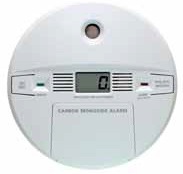
SKK
TOPEKA – The arrival of colder weather means more homes will be turning up the heat with fuel-burning appliances. These appliances include furnaces, ovens, space heaters, generators, indoor grills, and fireplaces that can unknowingly cause dangerous levels of carbon monoxide (CO) to build up in the home.
According to the Centers for Disease Control and Prevention, an average of 430 people die each year from unintentional carbon monoxide poisoning in the United States. In Kansas, from 2010 to 2014, there were annually an average of 148 emergency department visits, 23 hospitalizations, and 13 deaths due to unintentional carbon monoxide poisoning.
“Carbon monoxide is colorless and odorless,” said Cherie Sage, Safe Kids Kansas (SKK). “The symptoms of CO poisoning are similar to those of common winter ailments, like the flu. Without a CO detector in your home, your family can be poisoned without even realizing it’s happening.” Carbon monoxide poisoning can happen suddenly or cause poisoning over a longer amount of time. Carbon Monoxide detectors cost approximately $20 and can be purchased at most hardware and retail stores.
“Carbon monoxide can cause sudden illness or even death,” says Dr. Farah Ahmed, Environmental Health Officer with the Kansas Department of Health and Environment (KDHE). “Having a carbon monoxide detector with a battery backup near where people sleep saves lives.”
Tips to protect your family from CO poisoning:
- Prevent CO buildup in the first place – make sure heating appliances are in good working order and used only in well-ventilated areas. Don’t run a car engine or any other gas powered tool in the garage, even with the garage doors open. If you need to warm up your vehicle, move it outside first.
- Install detectors in the hallway near the bedrooms in each separate sleeping area and on every level of the home. Keep detectors at least 15 inches from all fuel-burning appliances.
- Follow manufacturer’s directions for installation, testing, and using CO detectors. There are many options and styles to choose from including hardwired, combination smoke and CO detectors, and battery operated. When you check your smoke alarm batteries each month, check the batteries on your CO alarms at the same time.
- Never use an oven or gas range for heating.
- Only use portable generators, gas camp stoves, and charcoal grills outside with proper ventilation. They cannot be used indoors, inside of a garage or enclosed porch.
- If more than one person in the home suddenly feels ill for no apparent reason, or if a CO alarm goes off, get everyone outside immediately and call 911 from a pre-arranged meeting place. Pay attention to pets, sometimes they will show signs of illness first. Don’t go back inside until the fire department or gas company says it is safe.
“Having a working CO alarm is just as important as having a smoke alarm,” said Doug Jorgensen, Kansas Fire Marshal. “These devices provide the best protection for early detection.”
The Kansas Office of the State Fire Marshal, through its “Get Alarmed, Kansas,” program, is working with fire departments across the state to deliver and install free smoke alarms, which include CO detection. For more information on “Get Alarmed, Kansas,” visit, www.firemarshal.ks.gov.
For more information about CO poisoning, visit www.safekids.org, or call the Poison Control Hotline at (800) 222-1222.
